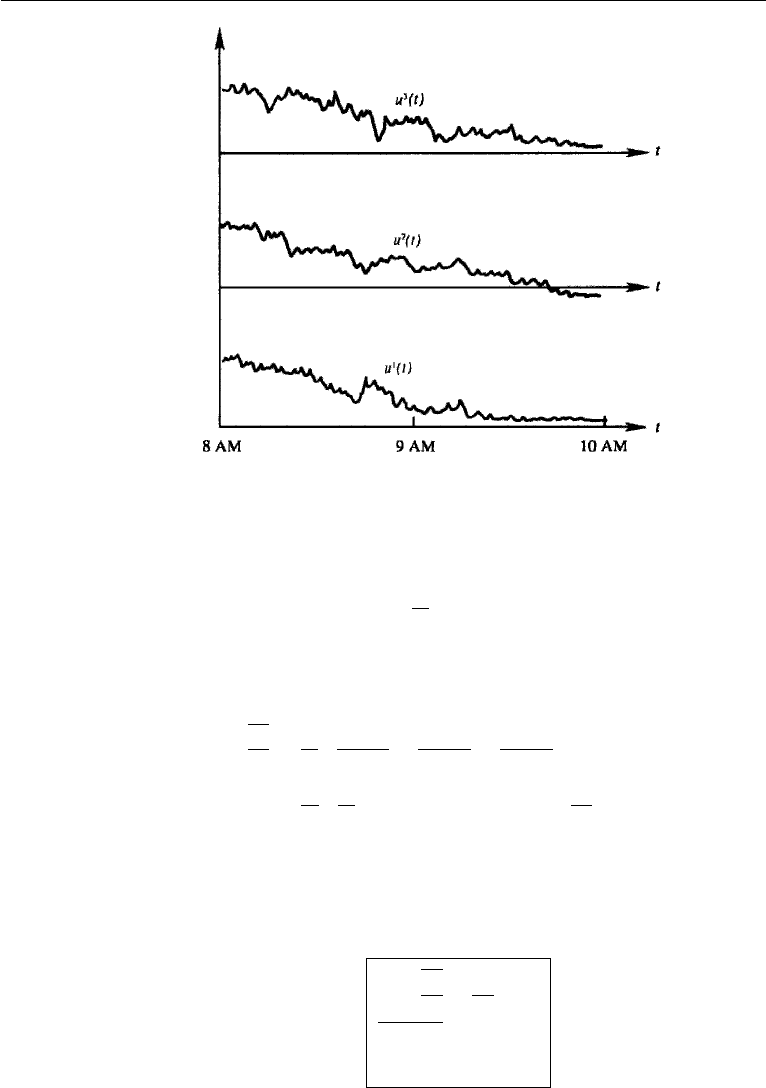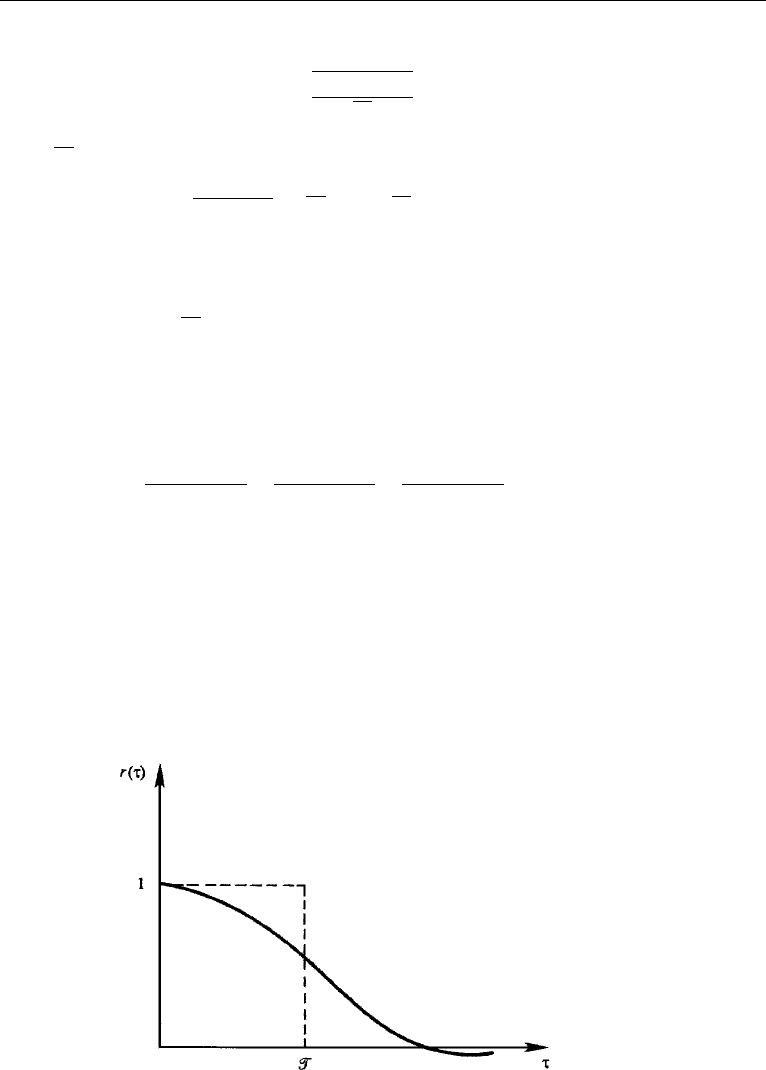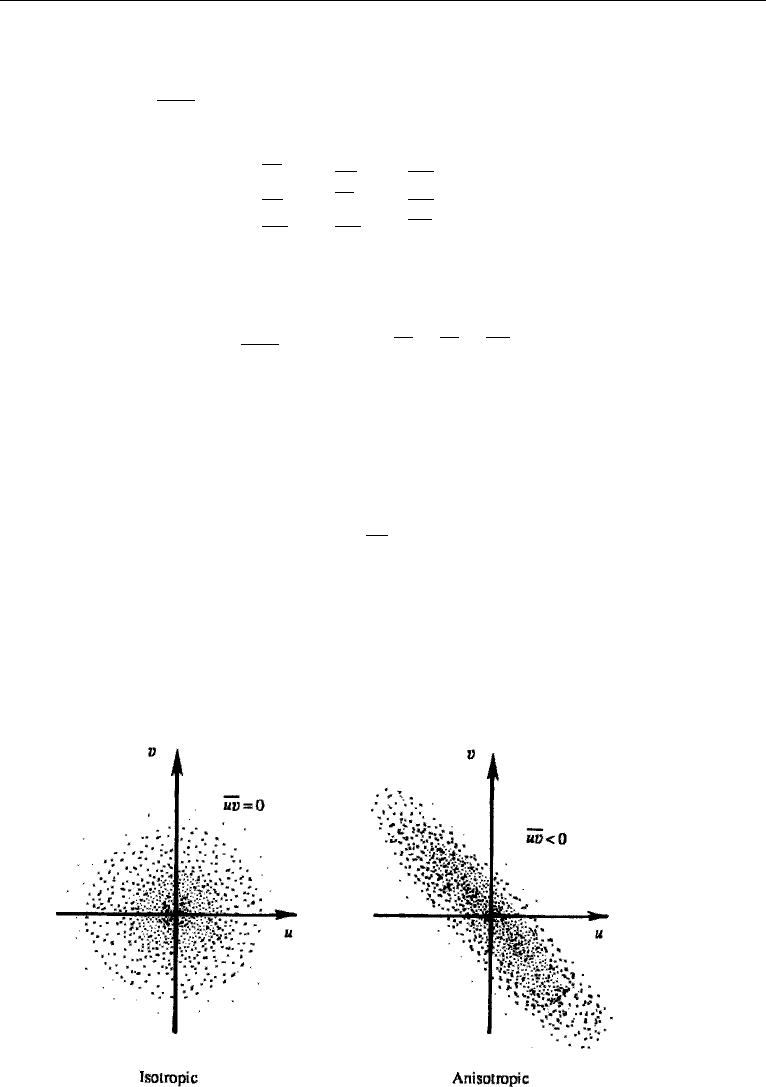Cohen I.M., Kundu P.K. Fluid Mechanics
Подождите немного. Документ загружается.


542 Turbulence
Figure 13.3 An ensemble of functions u(t).
each record and dividing the sum by the number of records. We therefore define the
ensemble average of u at time t to be
¯u(t) ≡
1
N
N
i=1
u
i
(t), (13.2)
where N is a large number. From this it follows that the average derivative at a certain
time is
∂u
∂t
=
1
N
∂u
1
(t)
∂t
+
∂u
2
(t)
∂t
+
∂u
3
(t)
∂t
+···
=
∂
∂t
1
N
{u
1
(t) + u
2
(t) +···}
=
∂ ¯u
∂t
.
This shows that the operation of differentiation commutes with the operation of ensem-
ble averaging, so that their orders can be interchanged. In a similar manner we can
show that the operation of integration also commutes with ensemble averaging. We
therefore have the rules
∂u
∂t
=
∂ ¯u
∂t
,
b
a
udt =
b
a
¯udt.
(13.3)
(13.4)

4. Correlations and Spectra 543
Similar rules also hold when the variable is a function of space:
∂u
∂x
i
=
∂ ¯u
∂x
i
, (13.5)
udx =
¯udx. (13.6)
The rules of commutation (13.3)–(13.6) will be constantly used in the algebraic
manipulations throughout the chapter.
As there is no way of controlling natural phenomena in the atmosphere and the
ocean, it is very difficult to obtain observations under identical conditions. Conse-
quently, in a nonstationary process such as the one shown in Figure 13.2b, the average
value of u at a certain time is sometimes determined by using equation (13.1) and
choosing an appropriate averaging time t
0
, small compared to the time during which
the average properties change appreciably. In any case, for theoretical discussions, all
averages defined by overbars in this chapter are to be regarded as ensemble averages.
If the process also happens to be stationary, then the overbar can be taken to mean
the time average.
The various averages of a random variable, such as its mean and rms value,
are collectively called the statistics of the variable. When the statistics of a random
variable are independent of time, we say that the underlying process is stationary.
Examples of stationary and nonstationary processes are shown in Figure 13.2. For a
stationary process the time average (i.e., the average over a single record, defined by
equation (13.1)) can be shown to equal the ensemble average, resulting in considerable
simplification. Similarly, we define a homogeneous process as one whose statistics
are independent of space, for which the ensemble average equals the spatial average.
The mean square value of a variable is called the variance. The square root of
variance is called the root-mean-square (rms) value:
variance ≡
u
2
,
u
rms
≡ (u
2
)
1/2
.
The time series [u(t) −¯u], obtained after subtracting the mean ¯u of the series, repre-
sents the fluctuation of the variable about its mean. The rms value of the fluctuation
is called the standard deviation, defined as
u
SD
≡[(u −¯u)
2
]
1/2
.
4. Correlations and Spectra
The autocorrelation of a single variable u(t) at two times t
1
and t
2
is defined as
R(t
1
,t
2
) ≡ u(t
1
)u(t
2
). (13.7)

544 Turbulence
In the general case when the series is not stationary, the overbar is to be regarded
as an ensemble average. Then the correlation can be computed as follows: Obtain a
number of records of u(t), and on each record read off the values of u at t
1
and t
2
.
Then multiply the two values of u in each record and calculate the average value of
the product over the ensemble.
The magnitude of this average product is small when a positive value of u(t
1
) is
associated with both positive and negative values of u(t
2
). In such a case the magnitude
of R(t
1
,t
2
) is small, and we say that the values of u at t
1
and t
2
are “weakly correlated.”
If, on the other hand, a positive value of u(t
1
) is mostly associated with a positive
value of u(t
2
), and a negative value of u(t
1
) is mostly associated with a negative value
of u(t
2
), then the magnitude of R(t
1
,t
2
) is large and positive; in such a case we say
that the values of u(t
1
) and u(t
2
) are “strongly correlated.” We may also have a case
with R(t
1
,t
2
) large and negative, in which one sign of u(t
1
) is mostly associated with
the opposite sign of u(t
2
).
For a stationary process the statistics (i.e., the various kinds of averages) are
independent of the origin of time, so that we can shift the origin of time by any
amount. Shifting the origin by t
1
, the autocorrelation (13.7) becomes u(0)u(t
2
− t
1
)
=
u(0)u(τ ), where τ = t
2
− t
1
is the time lag. It is clear that we can also write this
correlation as
u(t)u(t +τ), which is a function of τ only, t being an arbitrary origin
of measurement. We can therefore define an autocorrelation function of a stationary
process by
R(τ) =
u(t)u(t +τ).
As we have assumed stationarity, the overbar in the aforementioned expression can
also be regarded as a time average. In such a case the method of estimating the
correlation is to align the series u(t) with u(t + τ) and multiply them vertically
(Figure 13.4).
Figure 13.4 Method of calculating autocorrelation u(t )u(t + τ).

4. Correlations and Spectra 545
We can also define a normalized autocorrelation function
r(τ) ≡
u(t)u(t +τ)
u
2
, (13.8)
where
u
2
is the mean square value. For any function u(t), it can be proved that
u(t
1
)u(t
2
) [u
2
(t
1
)]
1/2
[u
2
(t
2
)]
1/2
, (13.9)
which is called the Schwartz inequality. It is analogous to the rule that the inner product
of two vectors cannot be larger than the product of their magnitudes. For a stationary
process the mean square value is independent of time, so that the right-hand side of
equation (13.9) equals
u
2
. Using equation (13.9), it follows from equation (13.8) that
r 1.
Obviously, r(0) = 1. For a stationary process the autocorrelation is a symmetric
function, because then
R(τ) =
u(t)u(t +τ) = u(t −τ )u(t) = u(t)u(t − τ) = R(−τ).
A typical autocorrelation plot is shown in Figure 13.5. Under normal conditions r goes
to0asτ →∞, because a process becomes uncorrelated with itself after a long time.
A measure of the width of the correlation function can be obtained by replacing
the measured autocorrelation distribution by a rectangle of height 1 and width
᐀
(Figure 13.5), which is therefore given by
᐀ ≡
∞
0
r(τ)dτ. (13.10)
Figure 13.5 Autocorrelation function and the integral time scale.

546 Turbulence
This is called the integral time scale, which is a measure of the time over which u(t)
is highly correlated with itself. In other words,
᐀ is a measure of the “memory” of
the process.
Let S(ω) denote the Fourier transform of the autocorrelation function R(τ).By
definition, this means that
S(ω) ≡
1
2π
∞
−∞
e
−iωτ
R(τ) dτ. (13.11)
It can be shown that, for equation (13.11) to be true, R(τ) must be given in terms of
S(ω) by
R(τ) ≡
∞
−∞
e
iωτ
S(ω) dω. (13.12)
We say that equations (13.11) and (13.12) define a “Fourier transform pair.” The
relationships (13.11) and (13.12) are not special for the autocorrelation function, but
hold for any function for which a Fourier transform can be defined. Roughly speaking,
a Fourier transform can be defined if the function decays to zero fast enough at infinity.
It is easy to show that S(ω) is real and symmetric if R(τ) is real and symmetric
(Exercise 1). Substitution of τ = 0 in equation (13.12) gives
u
2
=
∞
−∞
S(ω) dω. (13.13)
This shows that S(ω)dω is the energy (more precisely, variance) in a frequency
band dω centered at ω. Therefore, the function S(ω) represents the way energy is
distributed as a function of frequency ω. We say that S(ω) is the energy spectrum, and
equation (13.11) shows that it is simply the Fourier transform of the autocorrelation
function. From equation (13.11) it also follows that
S(0) =
1
2π
∞
−∞
R(τ) dτ =
u
2
π
∞
0
r(τ)dτ =
u
2
᐀
π
,
which shows that the value of the spectrum at zero frequency is proportional to the
integral time scale.
So far we have considered u as a function of time and have defined its autocor-
relation R(τ). In a similar manner we can define an autocorrelation as a function of
the spatial separation between measurements of the same variable at two points. Let
u(x
0
,t)and u(x
0
+x,t)denote the measurements of u at points x
0
and x
0
+x. Then
the spatial correlation is defined as
u(x
0
, t)u(x
0
+ x,t). If the field is spatially homo-
geneous, then the statistics are independent of the location x
0
, so that the correlation
depends only on the separation x :
R(x) =
u(x
0
, t)u(x
0
+ x,t).

5. Averaged Equations of Motion 547
We can now define an energy spectrum S(K) as a function of the wavenumber vector K
by the Fourier transform
S(K) =
1
(2π)
1/3
∞
−∞
e
−iK ·x
R(x)dx, (13.14)
where
R(x) =
∞
−∞
e
iK ·x
S(K)dK. (13.15)
The pair (13.14) and (13.15) is analogous to equations (13.11) and (13.12). In the
integral (13.14), dx is the shorthand notation for the volume element dx dy dz. Simi-
larly, in the integral (13.15), dK = dk dl dmis the volume element in the wavenumber
space (k,l,m).
It is clear that we need an instantaneous measurement u(x) as a function of
position to calculate the spatial correlations R(x). This is a difficult task and so we
frequently determine this value approximately by rapidly moving a probe in a desired
direction. If the speed U
0
of traversing of the probe is rapid enough, we can assume
that the turbulence field is “frozen” and does not change during the measurement.
Although the probe actually records a time series u(t), we may then transform it
to a spatial series u(x) by replacing t by x/U
0
. The assumption that the turbulent
fluctuations at a point are caused by the advection of a frozen field past the point is
called Taylor’s hypothesis.
So far we have defined autocorrelations involving measurements of the same
variable u. We can also define a cross-correlation function between two stationary
variables u(t) and v(t) as
C(τ) ≡
u(t)v(t + τ).
Unlike the autocorrelation function, the cross-correlation function is not a symmetric
function of the time lag τ , because C(−τ) =
u(t)v(t − τ) = C(τ). The value of the
cross-correlation function at zero lag, that is
u(t)v(t ), is simply written as uv and
called the “correlation” of u and v.
5. Averaged Equations of Motion
A turbulent flow instantaneously satisfies the Navier–Stokes equations. However, it
is virtually impossible to predict the flow in detail, as there is an enormous range
of scales to be resolved, the smallest spatial scales being less than millimeters and
the smallest time scales being milliseconds. Even the most powerful of today’s com-
puters would take an enormous amount of computing time to predict the details of
an ordinary turbulent flow, resolving all the fine scales involved. Fortunately, we are
generally interested in finding only the gross characteristics in such a flow, such as
the distributions of mean velocity and temperature. In this section we shall derive the
equations of motion for the mean state in a turbulent flow and examine what effect
the turbulent fluctuations may have on the mean flow.

548 Turbulence
We assume that the density variations are caused by temperature fluctuations
alone. The density variations due to other sources such as the concentration of a solute
can be handled within the present framework by defining an equivalent temperature.
Under the Boussinesq approximation, the equations of motion for the instantaneous
variables are
∂ ˜u
i
∂t
+˜u
j
∂ ˜u
i
∂x
j
=−
1
ρ
0
∂ ˜p
∂x
i
− g[1 − α(
˜
T − T
0
)]δ
i3
+ ν
∂
2
˜u
i
∂x
j
∂x
j
, (13.16)
∂ ˜u
i
∂x
i
= 0, (13.17)
∂
˜
T
∂t
+˜u
j
∂
˜
T
∂x
j
= κ
∂
2
˜
T
∂x
j
∂x
j
. (13.18)
As in the preceding chapter, we are denoting the instantaneous quantities by a
tilde ( ˜ ). Let the variables be decomposed into their mean part and a deviation from
the mean:
˜u
i
= U
i
+ u
i
,
˜p = P + p,
˜
T =
¯
T + T
.
(13.19)
(The corresponding density is ˜ρ =¯ρ +ρ
.) This is called the Reynolds decomposition.
As in the preceding chapter, the mean velocity and the mean pressure are denoted by
uppercase letters, and their turbulent fluctuations are denoted by lowercase letters.
This convention is impossible to use for temperature and density, for which we use an
overbar for the mean state and a prime for the turbulent part. The mean quantities
(U, P ,
¯
T)are to be regarded as ensemble averages; for stationary flows they can also
be regarded as time averages. Taking the average of both sides of equation (13.19),
we obtain
¯u
i
=¯p = T
= 0,
showing that the fluctuations have zero mean.
The equations satisfied by the mean flow are obtained by substituting the
Reynolds decomposition (13.19) into the instantaneous Navier–Stokes equations
(13.16)–(13.18) and taking the average of the equations. The three equations transform
as follows.
Mean Continuity Equation
Averaging the continuity equation (13.17), we obtain
∂
∂x
i
(U
i
+ u
i
) =
∂U
i
∂x
i
+
∂u
i
∂x
i
=
∂U
i
∂x
i
+
∂ ¯u
i
∂x
i
= 0,

5. Averaged Equations of Motion 549
where we have used the commutation rule (13.5). Using ¯u
i
= 0, we obtain
∂U
i
∂x
i
= 0, (13.20)
which is the continuity equation for the mean flow. Subtracting this from the continuity
equation (13.17) for the total flow, we obtain
∂u
i
∂x
i
= 0, (13.21)
which is the continuity equation for the turbulent fluctuation field. It is therefore seen
that the instantaneous, the mean, and the turbulent parts of the velocity field are all
nondivergent.
Mean Momentum Equation
The momentum equation (13.16) gives
∂
∂t
(U
i
+ u
i
) + (U
j
+ u
j
)
∂
∂x
j
(U
i
+ u
i
)
=−
1
ρ
0
∂
∂x
i
(P + p) − g[1 − α(
¯
T + T
− T
0
)]δ
i3
+ ν
∂
2
∂x
2
j
(U
i
+ u
i
). (13.22)
We shall take the average of each term of this equation. The average of the time
derivative term is
∂
∂t
(U
i
+ u
i
) =
∂U
i
∂t
+
∂u
i
∂t
=
∂U
i
∂t
+
∂ ¯u
i
∂t
=
∂U
i
∂t
,
where we have used the commutation rule (13.3), and ¯u
i
= 0. The average of the
advective term is
(U
j
+ u
j
)
∂
∂x
j
(U
i
+ u
i
) = U
j
∂U
i
∂x
j
+ U
j
∂ ¯u
i
∂x
j
+¯u
j
∂U
i
∂x
j
+ u
j
∂u
i
∂x
j
= U
j
∂U
i
∂x
j
+
∂
∂x
j
(u
i
u
j
),
where we have used the commutation rule (13.5) and ¯u
i
= 0; the continuity equation
∂u
j
/∂x
j
= 0 has also been used in obtaining the last term.
The average of the pressure gradient term is
∂
∂x
i
(P + p) =
∂P
∂x
i
+
∂ ¯p
∂x
i
=
∂P
∂x
i
.

550 Turbulence
The average of the gravity term is
g
[1 − α(
¯
T + T
− T
0
)]=g[1 − α(
¯
T − T
0
)],
where we have used
¯
T
= 0. The average of the viscous term is
ν
∂
2
∂x
j
∂x
j
(U
i
+ u
i
) = ν
∂
2
U
i
∂x
j
∂x
j
.
Collecting terms, the mean of the momentum equation (13.22) takes the form
∂U
i
∂t
+ U
j
∂U
i
∂x
j
+
∂
∂x
j
(u
i
u
j
) =−
1
ρ
0
∂P
∂x
i
− g[1 − α(
¯
T − T
0
)]δ
i3
+ ν
∂
2
U
i
∂x
j
∂x
j
.
(13.23)
The correlation
u
i
u
j
in equation (13.23) is generally nonzero, although ¯u
i
= 0. This
is discussed further in what follows.
Reynolds Stress
Writing the term
u
i
u
j
on the right-hand side, the mean momentum equation (13.23)
becomes
DU
i
Dt
=−
1
ρ
0
∂P
∂x
i
− g[1 − α(
¯
T − T
0
)]δ
i3
+
∂
∂x
j
ν
∂U
i
∂x
j
− u
i
u
j
, (13.24)
which can be written as
DU
i
Dt
=
1
ρ
0
∂ ¯τ
ij
∂x
j
− g[1 − α(
¯
T − T
0
)]δ
i3
,
(13.25)
where
¯τ
ij
=−Pδ
ij
+ µ
∂U
i
∂x
j
+
∂U
j
∂x
i
− ρ
0
u
i
u
j
. (13.26)
Compare equations (13.25) and (13.26) with the corresponding equations for the
instantaneous flow, given by (see equations (4.13) and (4.36))
D ˜u
i
Dt
=
1
ρ
0
∂ ˜τ
ij
∂x
j
− g[1 − α(
˜
T − T
0
)]δ
i3
,
˜τ
ij
=−˜pδ
ij
+ µ
∂ ˜u
i
∂x
j
+
∂ ˜u
j
∂x
i
.
It is seen from equation (13.25) that there is an additional stress −ρ
0
u
i
u
j
acting in a
mean turbulent flow. In fact, these extra stresses on the mean field of a turbulent flow

5. Averaged Equations of Motion 551
are much larger than the viscous contribution µ(∂U
i
/∂x
j
+ ∂U
i
/∂x
j
), except very
close to a solid surface where the fluctuations are small and mean flow gradients are
large.
The tensor −ρ
0
u
i
u
j
is called the Reynolds stress tensor and has the nine Cartesian
components
−ρ
0
u
2
−ρ
0
uv −ρ
0
uw
−ρ
0
uv −ρ
0
v
2
−ρ
0
vw
−ρ
0
uw −ρ
0
vw −ρ
0
w
2
.
This is a symmetric tensor; its diagonal components are normal stresses, and the
off-diagonal components are shear stresses. If the turbulent fluctuations are com-
pletely isotropic, that is, if they do not have any directional preference, then the
off-diagonal components of
u
i
u
j
vanish, and u
2
= v
2
= w
2
. This is shown in
Figure 13.6, which shows a cloud of data points (sometimes called a “scatter plot”)
on a uv-plane. The dots represent the instantaneous values of the uv-pair at different
times. In the isotropic case there is no directional preference, and the dots form a
spherically symmetric pattern. In this case a positive u is equally likely to be asso-
ciated with both a positive and a negative v. Consequently, the average value of the
product uv is zero if the turbulence is isotropic. In contrast, the scatter plot in an
anisotropic turbulent field has a polarity. The figure shows a case where a positive u
is mostly associated with a negative v, giving
uv < 0.
It is easy to see why the average product of the velocity fluctuations in a turbulent
flow is not expected to be zero. Consider a shear flow where the mean shear dU/dy
is positive (Figure 13.7). Assume that a particle at level y is instantaneously traveling
upward (v > 0). On the average the particle retains its original velocity during the
migration, and when it arrives at level y +dy it finds itself in a region where a larger
velocity prevails. Thus the particle tends to slow down the neighboring fluid particles
Figure 13.6 Isotropic and anisotropic turbulent fields. Each dot represents a uv-pair at a certain time.
